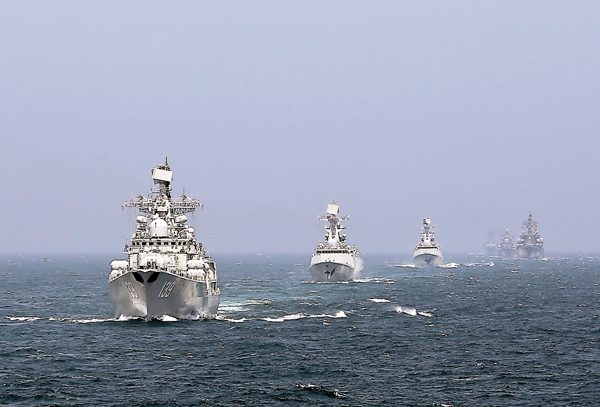 ■有意見指日本圖謀聲東擊西,意圖在東海問題上獲得更多籌碼和主動權。圖為中俄兩國早前在東海舉行軍演。 資料圖片
■有意見指日本圖謀聲東擊西,意圖在東海問題上獲得更多籌碼和主動權。圖為中俄兩國早前在東海舉行軍演。 資料圖片【原文】8月上任的日本防衛大臣稻田朋美,日前在華盛頓演講時稱,日方計劃與美軍在南海水域舉行軍演(joint training patrols ),提升日本在南海的行動能力。
倘若此番言論變成現實(if vision is translated into action),勢必觸犯中方在南海的核心利益和底線,致令剛剛呈回暖跡象的中日關係(Sino-Japanese relations)面臨倒退。事實上,中國擁有在南海無可爭辯的主權(undeniable sovereignty),日本作為域外國家,卻變本加厲地在南海問題上煽風點火,企圖配合美國的行動直接介入,只會使南海問題更複雜。
早有預謀插手 再添兩國裂痕
本月初在杭州舉行的20國集團峰會上,中國國家主席習近平在會見與會的日本首相安倍晉三時強調,中日關係現在正處於爬坡過坎、不進則退(no progress means regression)的關鍵階段。
這次是中日兩國首腦自2015年4月之後舉行的首次會談,外界都將此視為中日兩國關係開始回暖的跡象,但峰會剛剛結束,日本防衛大臣就搬出這番有損兩國關係(added tensions)的言論,日本當局到底要幹什麼?
去年9月,日本新安保法通過之後,就一直試圖把南海作為海外派兵的試驗地,日本自衛隊艦艇隊司令員曾放言,從確保海上交通線安全的角度而言,南海將直接影響到日本。去年11月,日本就與越南達成協議(agreement),允許日本自衛隊使用金蘭灣港;今年1月,日方宣佈其P-3C飛機在南海執行了巡航任務;3月,日本海上自衛隊潛艇在菲律賓停靠,是二戰結束後日本潛艇(submarines)第一次公開進入南海。可見,日本對南海問題的介入是早有預謀。
今年7月所謂「南海仲裁」結果出來之後,日方一直鼓動(sway )菲律賓落實仲裁結果,並在國際上製造輿論壓力,要求中國接受不合理、不合法的仲裁( unreasonable and illegal ruling),教唆南海其他當事國在南海問題上興風作浪。眼見這些圖謀都沒有得逞,日本就企圖赤膊上陣,直接插手南海事務。
觀察家分析4圖謀
觀察家分析,日本的圖謀無非是以下幾個方面:
一是增加日方在構建國際海洋秩序上的影響力(maritime influence),保持安倍一直聲稱的「日本在亞洲的領導地位」;二是企圖在南海問題上牽制中國,聲東擊西,意圖在以釣魚島為核心的東海問題上獲得更多籌碼和主動權;三是藉此渲染「中國威脅論」,為安倍政府修改和平憲法(pacifist constitution)和海外軍事擴張尋找借口;四是企圖離間(alienating)中國與東盟諸國傳統關係,擴大日本在東盟的影響力,力保其經濟利益。 (標題及小標題為編輯所加) (摘錄自文匯報社評17-9-2016)
Sino-Japanese relations to recede by unwelcomed interference
【譯文】Tomomi Inada, sworn in as Japan's new Defence Minister on August, said during her speech in Washington DC that Japan planned to step up its activity in the South China Sea through joint training patrols with the United States. Announced when Sino-Japanese relations seems to be easing, the bold statement clearly violates Chinese national interest in the region, and is set to freeze bilateral ties if vision is translated into action.
As a matter of fact, China possesses undeniable sovereignty over the South China Sea. As an outsider with no geographical proximity, Japan's intensifying involvement and cooperation with the U.S. in the South China Sea dispute will only complicate the regional issue.
During his meeting with the Japanese PM Shinzo Abe at the Hangzhou G20 summit early September, Chinese President Xi Jinping reiterated that Sino-Japanese relations had entered a key phase, where no progress means regression. The Abe-Xi meeting was the first between the two since April 2015, and was widely regarded as signs of improved ties between the two countries. What exactly is Japan's intention as the new Japanese Defence Minister added tensions again so soon after the summit?
Impairing already cracked relations
Ever since the passage of the new security law on September 2015, Japan has been trying to use the South China Sea as a testing ground for foreign conflict participation. A commanding officer from the Japanese Maritime Self Defence Force (JMSDF) has publicly stated that the Sea affected Japan's interest because the country is dependent on open sea lanes for resources. On November 2015, it signed an agreement with Vietnam which would allow JMSDF vessels to use the Cam Ranh Bay port facilities. This January, some JMSDF P-3C patrol aircrafts performed duties in the Sea; in March one of their submarines visited the Philippines and sailed into the Sea the first time since WW2. Japan's intention to gradually boost its presence in the region is crystal clear.
Actually, Japan has been trying to sway the Philippines into enforcing the so-called "South China Sea ruling" when the results were announced on July.
It has also manipulated international opinion in an attempt to force China to accept the unreasonable and illegal ruling. After these attempts proved all in vain, it steps up and directly interferes.
Four reasons to interfere
According to experts, Japan's ambitions can be summarised into four aspects.
The first is to boost its maritime influence and maintain Abe's "Japanese leadership in Asia". The second is to pin down China on the South China Sea dispute and divert attention from the East China Sea, where Japan claims to own the Diaoyudao Islands. The third is to promote the "China Threat Theory", so that the Abe administration has an excuse to rewrite Japan's pacifist constitution and re-militarise the country. The fourth is to expand Japan's economic interests and influence in the ASEAN by alienating China.■Jeffrey Tse [ywc_jeffrey@hotmail.com]
Learning Point
文中提到日本首相安倍晉三有意修改和平憲法,到底什麼是「和平憲法」?
《日本國憲法》是日本在第二次世界大戰戰敗被盟軍佔領後,由盟軍最高司令官總司令部主導撰寫。
其中,第九條明確規定日本放棄戰爭、不維持武力、不擁有宣戰權。以下為英文官方譯文:
ARTICLE 9
(1) Aspiring sincerely to an international peace based on justice and order, the Japanese people forever renounce war as a sovereign right of the nation and the threat or use of force as means of settling international disputes.
(2) In order to accomplish the aim of the preceding paragraph, land, sea, and air forces, as well as other war potential, will never be maintained. The right of belligerency of the state will not be recognized.
